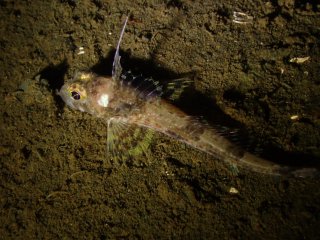The Hood ‘Canal’ (fjord) is a long, somewhat deep fjord in Washington guarded by a shallower underwater sill that limits circulation between it and the rest of the Puget Sound. It is also a less-developed area of the region, with no major cities or ’tier 1’ rivers flowing into it.
The waters and conditions here are considered distinct when it comes to things like species distributions, subsurface visibility patterns, dissolved oxygen levels, stratification, temperature etc.

iNaturalist.org
order Rajiformes
(CC-BY-NC-ND)
iNaturalist.org
order ActiniariaIn the summer, visibility for diving can surpass what is seen in the more seasonally and tidally-affected basins (not to mention riverine, agricultural, industrial, and urban wastewater volumes, population densities, eutrophication, etc.)

(CC-BY-NC-ND)
iNaturalist.org
Epizoanthus scotinusA drawback of the protection this basin enjoys is that surfaces collect silt, and fewer areas are found where strong tidal currents might otherwise clean the reefs and rock features.

(CC-BY-NC-ND)
iNaturalist.org
Octopus rubescensFlagpole Point
One of several exceptions is the subsea rock pinnacle known as Flagpole Point (which is named so because we like to put flags on prominent things, of course.)
A more interest name for it might be “cloud mountain” (sbadil q̓aƛ̕əb in native Lushootseed?), given the abundance of cloud sponges on the deeper part of the reef!

(CC-BY-NC-ND)
iNaturalist.org
Aphrocallistes vastusThis is a giant rock reef midway down the fjord that sticks out into consistent tidal flows that ebb and flow down its ~80km length.

justinthedeeps.com
Access
In Washington State, private ownership of property extends to the low tide line (or lower, according to anyone defending popular beachfront property). The majority of good diving spots are publicly inaccessible without a boat.
Flagpole Point is basically a boat dive, but can be dived from shore with a ~200-metre swim from a private access point granted by Mike’s Beach Resort. Many do the swim, including some who do it against currents, with added risks therein–including boat traffic!
It is seldom safe to be a diver on the surface away from shore, even with a large fluorescent SMB.
The Dive
This was my first time diving this site, though I have dived others nearby including Sund Rock. I was expecting to see a lot of fish, since this is considered a protected no-fishing spot. And a lot of big wolf eels, who love this fjord and its innumerable rocky dens.

justinthedeeps.com
The reef more than delivered! With a full moon flood gathering steam during the dive, fleets of rockfish soared in the snack-rich updrafts sweeping over the reeftop at ~18 metres. Having seen a lot of that at current-washed sites like Keystone, I decided to venture further down the sloping walls in search of more encounters.

(CC-BY-NC-ND)
iNaturalist.org
Anarrhichthys ocellatusAs I descended, the water reliably cooled and cleared, and the sea life seemed to get bigger, cleaner, and more interesting. (it is the opposite at many other dive sites.)

(CC-BY-NC-ND)
iNaturalist.org
Sebastes caurinusAdult rockfish were now facing off with me, seeming to guard their hard-earned dens. Every few metres there was another large wolf eel, making that face. This is also a popular site for giant pacific octopus, and every year divers seem to find them tending to their beautiful eggs.

(CC-BY-NC-ND)
iNaturalist.org
Acantholithodes hispidusEventually I reached what seemed to be a sloping bottom, and there I found a field of curious amusements like a ‘stealthy’ red octopus, and multiple bottom-dwelling (demersal) fish that were new to my camera.
(CC-BY-NC-ND) iNaturalist.org (CC-BY-NC-ND) iNaturalist.org (CC-BY-NC-ND) iNaturalist.org (CC-BY-NC-ND) iNaturalist.org



There was of course a spotted ratfish around to supervise.

(CC-BY-NC-ND)
iNaturalist.org
Hydrolagus collieiSteep and deep
Clear-headed on 18/44 diluent with plenty of O2 and bailouts, I could have thoroughly enjoyed another 10+ minutes of serene exploring at what seemed to be the bottom section of rock reef here. But the fish survey scientists with whom I’d tagged along were already on their route back to shore!
66 minutes (incl. proper deco and SMB procedures) was a record for short dive length for me on a dive like this. But we’ll be back!

justinthedeeps.com
More info
For some of the latest public dive reports about this site, check out pnwdiving.com:



















